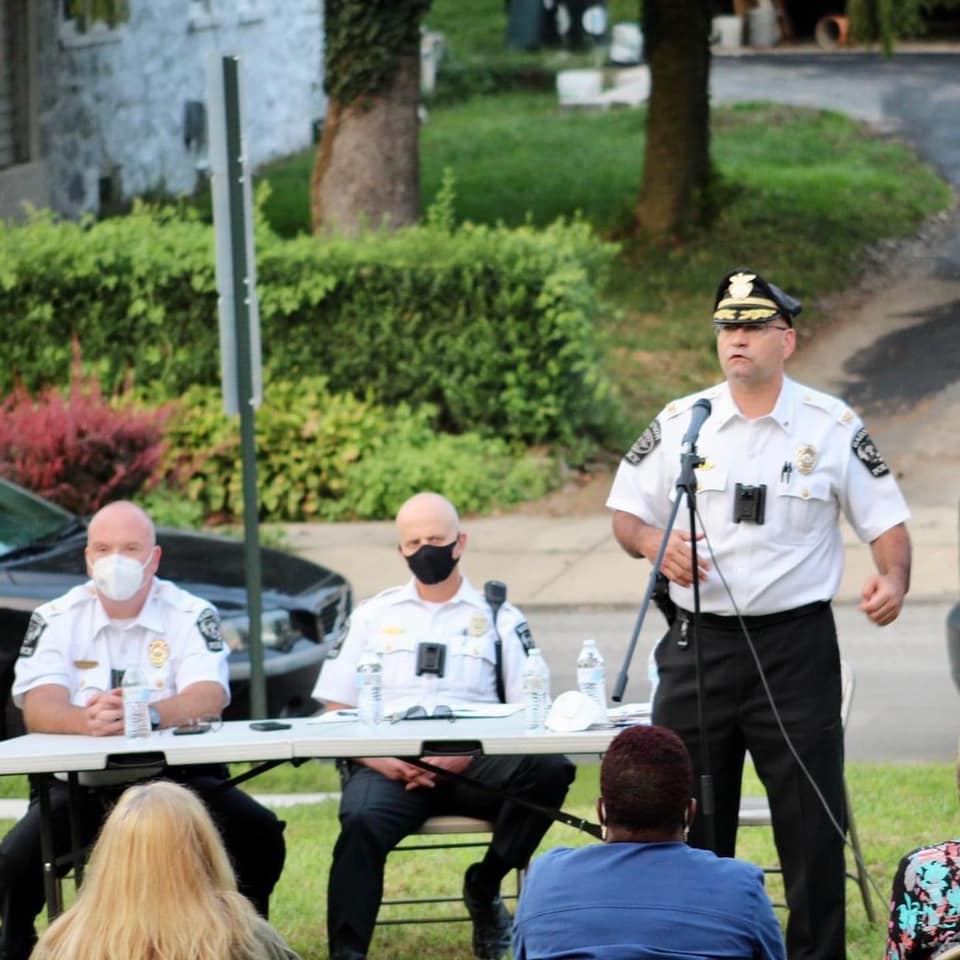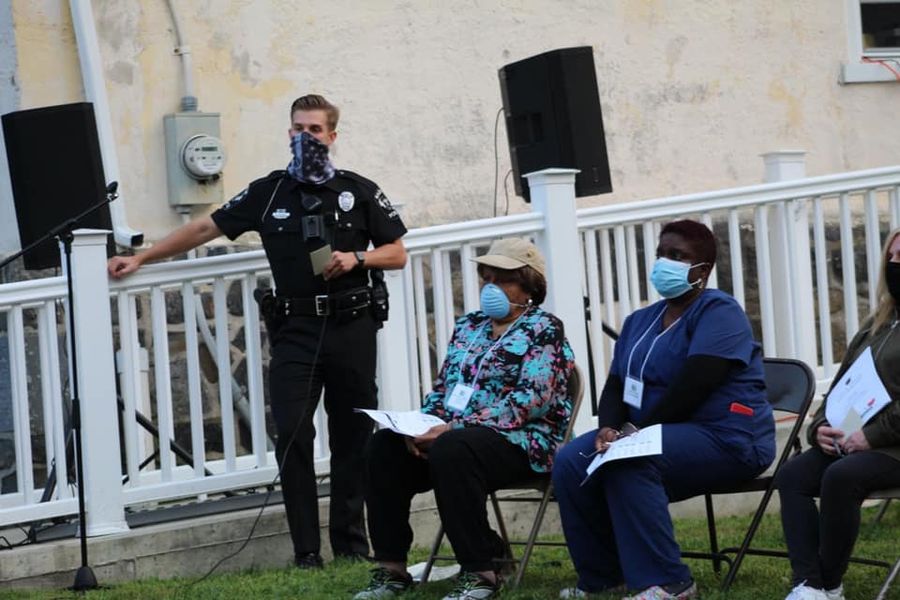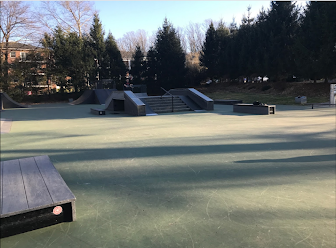A Look Inside the Radnor Police Department

Photo by Ellie Davis
November 5, 2020
The American, Pennsylvanian, and POW-MIA flags fly high over the Radnor Township Municipal Building. In the North wing, opposite from where the School Board and Board of Commissioners meet, the Radnor Police Department manages its daily operations.
In today’s media, the words “police department” seem to always coincide with images of Black Lives Matter protests, stories of discrimination, and even mugshots of former officers convicted of crimes. With these stories, I felt like I knew more about the Minneapolis or Portland Police Departments than my own local police department. Therefore, I visited the Radnor Police Department to better understand how it functions and to see where Radnor fits in the broad picture of national news.

In the waiting room of the municipal building, on nearly every available wall and surface various Radnor athletic memorabilia hang proudly. To my right, Olympian Kia Davis bounded from the starting line; to my left baseball players Chief Bender and Home Run Baker stood proudly, and on the center coffee table the Guide to the Main Line magazine beckoned for my attention. Past the front desk, where Vetta DiMieo and Lori Denicola work to keep the Records Room in order, and through a windowless locked door, the central police department office is noticeably less cheerful. Luckily, good decorations aren’t a requirement for good policing.
With a demeanor just chipper enough to remind one of the Sesame Street police officers singing “we’ll watch out for you,” Officer and Public Affairs Manager Brady McHale gave me a tour of the department’s facilities.

Towards the back corner of the office is the conference room, with a typical wide oval wooden table. As Superintendent Chris Flanagan explained, because of the institutional nature of the building, the best way to connect with the community is to “go on the road.”
“We’ve attended many community events, picnics, ice cream socials,” said Flanagan. During one such event, the officers came to speak with Mrs. Pearsall and student government leaders at the high school. As Justin Nourian, the current Junior Class President, shared, “the three [officers] seemed interested in connecting with young people and bridging the divide between law enforcement and citizens.” Student Executive Director Sheila Esgro added “the police expressed that they wish to hear from students and better understand our issues. It is important to have a dialogue with the police so that they understand what is going on in our lives, and we understand how they can help.”
Community members also interact with and assist the police department through the Radnor Citizens Police Organization (RCPO), informally called the “town watch” group. To be a “town watcher,” a community member must be over 18, clear a background check, and go through the proper training, which has recently been updated to include anti-bias training. They help with events such as the Wayne Fall Festival, and pumpkin picking at the willows. Recently at community events, they have given people gentle reminders to wear their masks. “If they see what they interpret as crime, just like any citizen, they dial 911,” Said Officer McHale. Interested community members, however, don’t need to join the RCPO to learn about the local police department — anyone over 18 can join an officer for a “ride-along.”

Coming up this week, the officers will be attending the annual Wayne Trick or Treat to hand out candy. “That’s where you meet people, they may tell you you’re great, they may tell us that we have a problem.” With this open and engaged style of policing, community members have more opportunities to engage with the police and voice their concerns. For instance, earlier this fall, at a Town Hall event hosted in collaboration with the Radnor Township Civic Association, community members had the opportunity to discuss their concerns with Superintendent Flanagan and other members of the police department. At this event, some people asked about the diversity of the Radnor Police Department, as did I when meeting with Superintendent Flanagan, to which he responded “I cannot tell you because I am making an assumption.”

For years, activists have suggested diversifying police forces to minimize community-police tensions. The Radnor Police Department does not take race into account during the hiring process. As the Superintendent explained, due to federal laws, “I cannot ask you your race, your religion, if you have a medical condition.” Still curious about the Police Department’s racial makeup, and to avoid making assumptions about the officers’ respective ethnic identities, I asked whether a black community member would be able to point to an officer and say, “They look like me.” Superintendent Flanagan responded with the same answer that “we cannot discuss how someone identifies.” The Radnor Police Instagram and Facebook pages show that the department is largely, if not completely, white.

They are certainly not skimping on their recruiting process — look no further than the giant flashing “we’re hiring” sign that has appeared on Lancaster Avenue. They spend close to $5,000 per hire on advertising and often visit local community colleges and police academies to try “to get as much diversity and as many different people as possible,” said Flanagan.
Back in the central office, officer McHale and I got the chance to speak briefly with Sergeant Mark Stiansen, who oversees the high-way patrol unit, which deals with “heavy traffic enforcement.” So, if you’re caught speeding, you’ll talk to them, but as Sergeant X said, “if you are, we’re all very nice.”Also as part of the job, officers regularly visit schools to teach students about safety on the roads. A few weeks ago during back to school season, officer Patrick Lacey talked to elementary schoolers about bus safety.

As of 2013, this division managed the use of their seven motorcycles, which they use to reach locations on the Radnor trail, college campuses, or athletic fields that are inaccessible to four-wheel vehicles. Two of the seven are proudly on display in front of the North Entrance to the building. These motorcycles also are often used for parades or marches, such as the recent Main Line Black Lives Matter March.
To safely support the over 1,000 protestors who marched from Wayne to Paoli, the Radnor Police Department partnered with the Tredyffrin Township, Easttown Township, Septa, and Amtrak Police Departments. Radnor also assigned officers to meet with the organizers of the event to have a direct communication pathway. Superintendent Flanagan, who said he agreed “100 Percent” with the goal of the Main Line march, commended the protestors for their efforts, and for his help, he said he has “never received more thank yous as a police officer.”

Motivated by the national movement, these protestors turned to their local police department with questions. In response to the protestors’ requests, specifically, the “8 Can’t-Wait” campaign, the Radnor Police Department published a document that summarizes the status of Radnor’s use of force policies. Radnor Police’s policy already satisfied six of the “8 Can’t-Wait” requests in 1998, including the ban of chokeholds and a mandatory verbal warning before shooting. To fully satisfy the 8 requests, in 2020 Radnor expanded its de-escalation training and updated its use-of-force policy to require officers to intervene to stop any “unnecessary or excessive force.” To provide further transparency, they also recently published their full use-of-force and body cam policies.
In 2020, the Radnor Police Department has shown how it has been ahead of the curve with its use-of-force policies, though it has not always stayed out of the spotlight of racial controversy. In 2015, former officer and Asian-American Nick Lai filled a lawsuit against the Radnor Police Department alleging employment discrimination. As reported by Philadelphia Magazine, in the complaint Nick Lai wrote “I have 17 years experience in the police field and never witnessed as much prejudice or racial profiling until I was hired by Radnor Police Department.” In the case documents, Lai names Superintendent of Police William Colarulo, Lieutenant Andrew Block, Sergeant Mark Stiansen, Officer Steven Bannar, Officer Patrick Lacey, and Sergeant Joseph Maguire, alleging that the “Defendants discriminated against him based on his race and national origin.” The story received extra media attention because Lai’s brother-in-law, Jeffrey Lurie, owns the Philadelphia Eagles. The case ended in April of 2017 with a non-disclosed settlement.
While the case was pending, in 2016, after the murder of five Dallas police officers, Superintendent Colarulo was the subject of further media controversy after telling Philadelphia Inquirer reporter William Bender that BLM is a “violent, hateful organization that condones violence against police. ” A week later, at a Board of Commissioners meeting, over 200 attendees gathered to share their concerns over his comments. Superintendent Colarulo apologized for his statement, saying “I made a blanket statement which I should not have made,” and went on to discuss the department’s transparency policies, how it rewrote its stop and frisk policy, and its community engagement efforts.
After Superintendent Colarulo’s statement, community members shared their public comments for more than two hours. Howard Childs, Reverend of the Second Baptist Church in Radnor, Radnor Girls Basketball coach, a lifelong Radnor resident, and Radnor High School alum, took the stand to share parts of his experience in Radnor as a black man. “When you go into a deli sometimes, and you’re the only black man in there,” he said, “and everyone turns to look at you, you don’t know what that does to you on the inside as a black man and growing up in this township.”

He also shared an experience with a particular Radnor Police officer who stopped him while driving three times. “All three times he never gave me a citation, do you know what that feels like on the inside?” he asked. In a recent interview, Childs shared that although “he was ticked off, one or two people aren’t going to be a representation of that full police force.” Despite this negative experience, he continued to learn about the Radnor Police Department through attending the Radnor Citizens Police Academy, and he said “the training that these officers get here, it blew my mind away.”
In the same comment Childs also shared a story of how he facilitated a meeting at his church between community members concerned about police harassment, and officers, including then Lieutenant Flanagan. Through attending services at the Second Baptist Church, and community barbecues, Childs said “Flanagan has been in the black community,” and “I say with pride now that I know Lieutenant Flanagan.” In the end, Childs called Colarulo a “gentleman” who he believes misspoke, and after ten minutes at the podium, he told the officers “you guys do a great job, and black lives do matter.”
Since 2016, as Childs explained in an interview, because of his relationship with Superintendent Flanagan, he has become more involved with the Radnor Police, and if today he felt like he was unfairly stopped by a police officer, he would feel comfortable going to speak to Flanagan.
Childs also mentioned Sergeant Maguire in his statement when discussing the positive interactions of the police officers and the black community. On the lower level of the Police Department, Officer McHale and I briefly said hi to Maguire, who has dedicated 41 years of his life to the Radnor Police Department. As just one out of his many responsibilities, Sergeant Maguire is one of the two people who sees and manages any complaints filed about the Radnor Police Department.
Also on the lower level, Officer McHale and I walked through the patrol room, where officers can file any reports from the day, as well as the roll call room, where officers meet with their Sergeant to begin their 12-hour shifts. The whole layout looked surprisingly like the season one set of The Wire, just with smaller computers. They even had the mugshot wall and a map with thumbtacks to match, but, before I could ask, Officer McHale specified that, to my disappointment, no, I could not take a picture.
As McHale explained, in a 12-hour patrol shift any given officer can expect to respond to about 30 calls a day. In addition to traffic control, the police manage issues ranging from animal control and domestic abuse calls to blocking off streets for block parties. “It’s been a busy time for us since I’ve been here, we’ve had a couple of murders, increases in crime,” explained Superintendent Flanagan, who has been in his current position for about two years. The return of students has also added to the Police Department’s busy schedule, though they are happy to see kids back in school.
With the return of students to school, Officer McHale encouraged all students to “respect yourself and everyone else. One of the biggest things we see every year is what goes on online, whether it’s cyberbullying or Snapchat issues — nothing is ever deleted.” If a young person in Radnor Township does make a bad decision, whether with social media or other minor, summary offenses, they may have the opportunity to go before the Community Youth Aid Panel, instead of going before a formal court. This panel of trained community members acts as “a diversionary program, so they want you to have a consequence for your action but also learn from it,” explained officer McHale.

Towards the end of my tour, I commented on the skatepark visible from the police department windows. “They’re out there at seven am,” said Officer McHale. The Radnor Police Department constantly strives for this close proximity to the community. As the Superintendent said, “ It’s not the policing against the community, all of us are together.”
At the end of our conversation, I asked Superintendent Flanagan what he would like the students at RHS to know. “I ask the Radnor students that it is so important that they properly educate themselves. Come find out for yourself, come interact, come say hello, come meet us, come look at us, see what’s going on, tell us what’s happening, understand that the police are the community. We stand beside you. We protect you”






